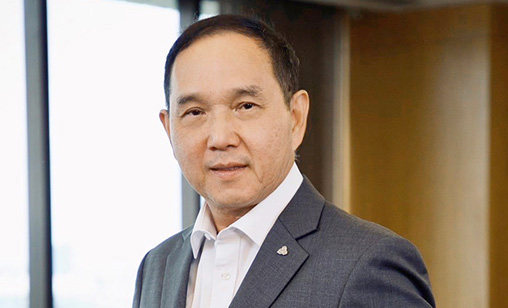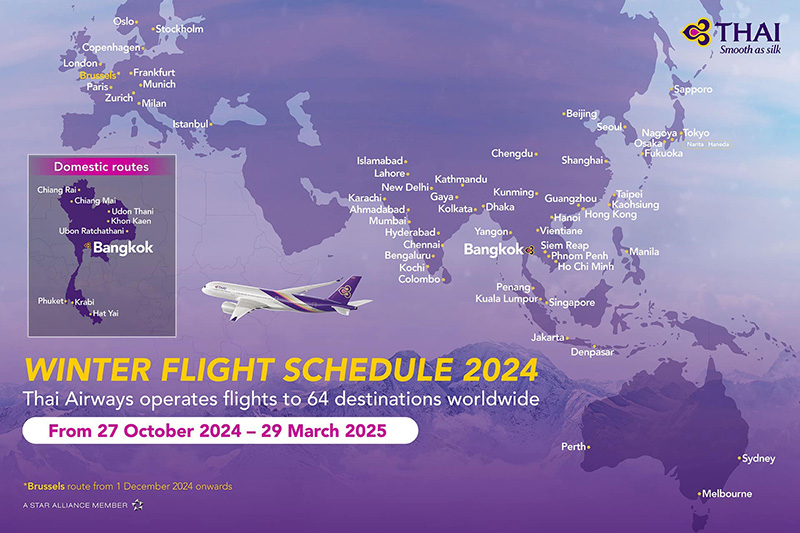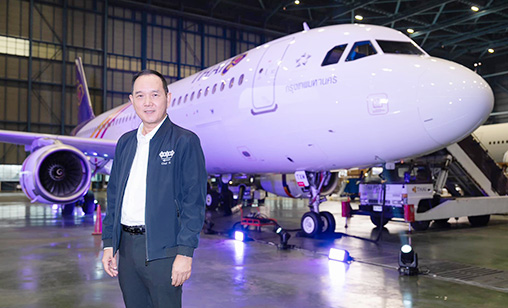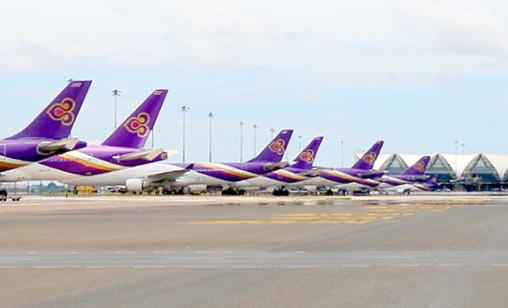Cover Story
Back in the game
After seeking bankruptcy protection as the pandemic struck down global airline flying in 2020, Thai Airways International has clawed back from crisis. Its rehabilitation plan is nearing completion and a renewed optimism pervades at the airline, CEO Chai Eamsiri told associate editor and chief correspondent, Tom Ballantyne.
October 1st 2024
It took strong leadership and tough strategic decisions, not to mention some serious cost-cutting, but Thai Airways International (THAI) is definitely back in the game. Read More » Almost all criteria necessary for the carrier to exit its four-year rehabilitation plan have been met, THAI CEO, Chai Eamsiri, told Orient Aviation last month.
“We will submit the filing to exit the plan, maybe in April or early May,” Eamsiri said. “After that, we will call the AGM of shareholders, maybe in early April, to appoint a new board of directors. That means we can fulfil all the criteria (for exiting rehabilitation).”
 |
| 'Asked if he had any issues with delivery delays from aircraft manufacturers, THAI CEO Eamsiri pointed out it has been an issue for some time, but it is not only affecting THAI. “It’s not only affecting us. All other airlines are facing the same issue. This is an equal playing field. We have a problem. The others also have a problem. So, I don’t have to worry very much about this issue because everybody is the same' |
| Chai Eamsiri THAI CEO |
THAI’s arrival at this juncture in its history has been a classic lesson in recovery from financial bad times. Eamsiri said his priorities, in no specific order, are to be totally customer centric, have commercial excellence, maintain cost competitiveness and have a commitment to a culture of continuous improvement.
Already his focus on these four strategic goals is paying dividends. Last year, THAI booked revenue of US$4.9 billion, up 57% from $3.1 billion in 2022. Net profit was $782 million compared with a net loss of $7.5 million the previous year. For first-half this year, THAI announced a net profit of $80.7 million. The airline carried some 13.8 million passengers last year, up from nine million 12 months earlier.
As part of the airline’s restructuring, THAI’s operations were streamlined, employee numbers were slashed and older aircraft retired, including its six A380s and 18 B747-400s. It also integrated its regional subsidiary, Thai Smile, into mainline operations.
“We turned this crisis into an opportunity. We had to face the pandemic. It was the same for the other airlines. We cut the workforce by half, from 30,000 employees to 15,000. We trimmed capacity, especially aircraft that were not performing well,” Eamsiri said.
“Older generation aircraft have high costs of operation. We got rid of them. The remaining aircraft in our fleet are new generation, namely the A350, 787 Dreamliner and the narrow-body A320.
“During the pandemic, we renegotiated all our leases with lessors. We think we are very competitive in terms of aircraft lease costs.”
The rationalization has increased the productivity of employees, he added. As well, as more digital solutions are introduced to the company’s operations, less people are employed in production, he said.
Absorbing Thai Smile and its 20 A320s - it had been reporting losses for ten years - into the mainline airline was an advantage in cost and network terms, Eamsiri said. Competition in the Thai low-cost market was intensifying and THAI wanted to move away from that space.
“We should be in a place where we are using our strength. Our strength is we are a network airline. Our strength is being a full-service carrier. To have two organisations, it’s double cost. You have two CEOs. You need to have two of everything. Every position is double cost. Now you only have one. You have only one CEO,” he said.
 |
Eamsiri said Bangkok is at the heart of Asean. “We have a geographical advantage among Asian cities and we make use of that. We will make Bangkok a hub, especially for the Asia-Pacific and Asean countries. Since last year, we have restructured our network,” he explained.
THAI, a Star Alliance member, flies to 64 destinations worldwide and is increasing frequencies on key routes. “We are top among the Asian carriers that fly to Europe, to the most cities in Europe. By the end of this year, we will be operating to 11 cities in Europe, each of them at least daily, some of them double daily, such as London and Frankfurt,” he said.
“We are carrying long-haul passengers from Europe and also from Australia, where we serve three cities, Sydney double daily, Melbourne double daily and Perth daily.
“We think we are strong enough for the time being for Europe. The area we think we still lag behind is the Asia-Pacific. We need to put more capacity in the Asia-Pacific to complete our network.”
The latest routes THAI has launched to date this year are Bangkok to Milan, Oslo and Brussels. This is where the merging of Thai Smile into THAI comes into play.
“When we are selling a ticket from Europe or anywhere else outside Bangkok, we are selling the destination. Not point to point. For example, if the passenger wants to fly to Phuket, Krabi, Chiang Mai or another secondary city in Thailand they can buy the ticket directly from their origin, from their home town in Europe or Australia,” Eamsiri said.
“We can sell the ticket as one package to the destination. These intercontinental flights will feed into Bangkok and we will disperse those passengers onto our regional routes. In essence, it means long-haul passengers from Europe or Australia can book one ticket through to their regional destination, rather than having a ticket with THAI to Bangkok and a separate ticket with THAI Smile for their onward regional flights.”
 |
One country where there has been realignment is China. “Of course we cannot deny China is an important market for everyone, not only THAI. Domestically, China is 100% or above 100% pre-pandemic already, but in terms of international travellers it is not back to that level. Not yet. We put our capacity [into China] at let’s say only 50% of what it used to be. But we have an alternative market replacing China,” he said.
“We have expanded a lot to India. Right now, we fly to 10 major and secondary cities in India. This is a market we try to have replace China.”
THAI is rebuilding its fleet. So far this year it has accepted multiple additional A350-900s as well as 787-9s and used A330-300s into its fleet. It has more A350-900s and B787s, including 45 Dreamliners, on order. To accommodate growth, the flag carrier will increase its aircraft from 103 today to 143 by 2029.
The airline also is buying 32 more A320s for its short-haul network with deliveries next year and in 2026. When all the ordered aircraft arrive at THAI, its fleet will include 32 A321neo and 20 A320s.
Next year THAI is planning to acquire 13 more wide-body and narrow-body aircraft, Eamsiri said. The carrier’s existing 20 A320s are being refurbished. “Currently, we have all of them equipped with economy class 168 or 174 seat configurations. We will remove the first four rows of economy and install 12 business class seats. We will have Wi-Fi for passengers to use their devices on board for streaming movies and music free of charge,” he said.
“This will allow seamless transfer with business class from intercontinental connecting with business class in regional or domestic flights through to end destinations. The A320 refurbishment will begin in December and be completed by next May.”
Its fleet of 17 B777s also are to be upgraded, including new full lie-flat business seats and the latest Wi-Fi IFE. The airline will introduce a new Premium Economy class on its long-haul flights and is considering a refresh of its first class product.
 |
Deliveries of THAI’s new Dreamliners are scheduled to begin in 2027 and run through to 2030.Acquiring capacity in the short term is the most challenging part, Eamsiri said.
THAI also is examing the feasibility of spinning off some units, particularly MRO and catering, into separate subsidiaries. Some of the airline’s business units have above average profit margins, at almost 20%, compared with the main airline’s annual profit margin of 5%-6%.
“Should these business units become our subsidiaries, the rewards for the staff will be better because they might make more money than Thai Airways main airline operations,” Eamsiri said and added the change could give the parent airline “more bandwidth” to focus on its own operations.
THAI had planned to build a MRO facility in U-Tapao in partnership with Airbus, but the European manufacturer pulled out in 2020. At press time, THAI was in discussions with Bangkok Airways about the two phase project. Construction of the first phase, three hangars for wide-bodies and two for narrow-bodies, will be followed by another three hangars in the second phase.
Eamsiri said the project will support Thailand’s eastern economy corridor plan to revitalize relatively underdeveloped eastern Thailand.
As it presses on with finalizing its rehabilitation, there could be one very significant change at THAI compared with its pre-pandemic life. It is unlikely to return to being a State-owned entity.
“We have demonstrated in the past four years, since entering rehabilitation that the company can succeed. So I don’t think it is worth it for us to be a state enterprise once more after being a public corporation,” Eamsiri said.
“We are more agile and have a better business perspective. When there is a change, employees can adapt faster. They dare to make decisions. We should not go back to being a state enterprise.
“With these strategies, Thai Airways will be able to operate faster, cope with challenges, adapt to change quickly and develop and innovate to support new business opportunities for strong and sustainable growth in the future.”
Chai Eamsiri was appointed CEO of THAI on February 1, 2023. Previously the airline’s chief financial officer, he is a 39-year veteran of the flag carrier. Born in a small village in Thailand, he was raised in humble circumstances. Since taking on the role of CEO at THAI, he has brought a fresh perspective and an innovative approach to running the airline. His strategic vision and decisive management style have quickly earned him respect within the organization and the aviation community. Under his leadership, THAI has recorded growth and expanded by adding routes to its network and streamlining operational efficiency. He has spearheaded initiatives to enhance customer experience and internal processes, positioning the airline as a leading player in the competitive market. Given the pressures of running an airline, one of the world’s most complex businesses, let alone a carrier emerging from four years of rehabilitation, it is not surprising Eamsiri enjoys whatever time he can find to relax. The biggest thing, he said, is playing golf with old friends. “I get away from the business and talk about the good old days.Talk about the nonsense. Talk about the good things in the past,” he said. Or he spends family time at home, watching movies or listening to music. He has several hobbies, among them hiking and cycling. An art enthusiast, he finds solace in visiting galleries and museums around the world. He also has a passion for the culinary arts and enjoys experimenting with new recipes in his kitchen. He has an MBA from Kasetsart University, the largest university in Thailand, and an undergraduate degree in marketing from Assumption University. |